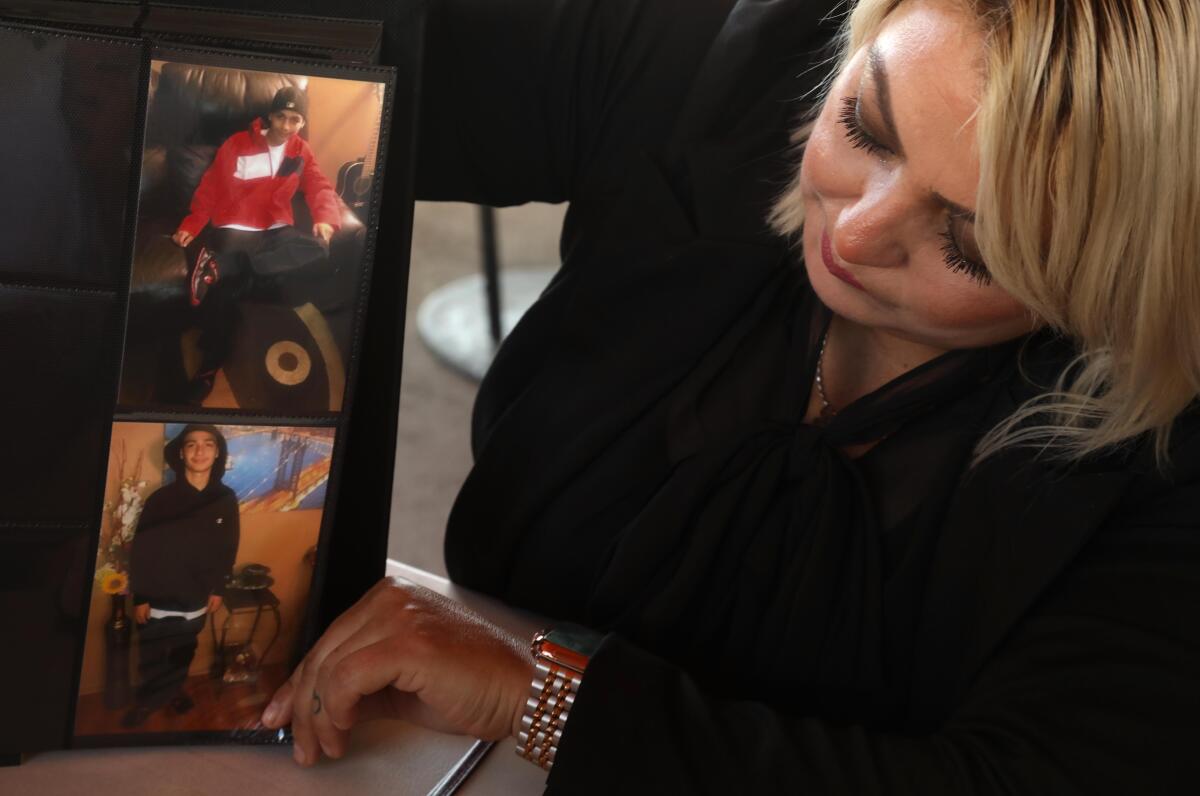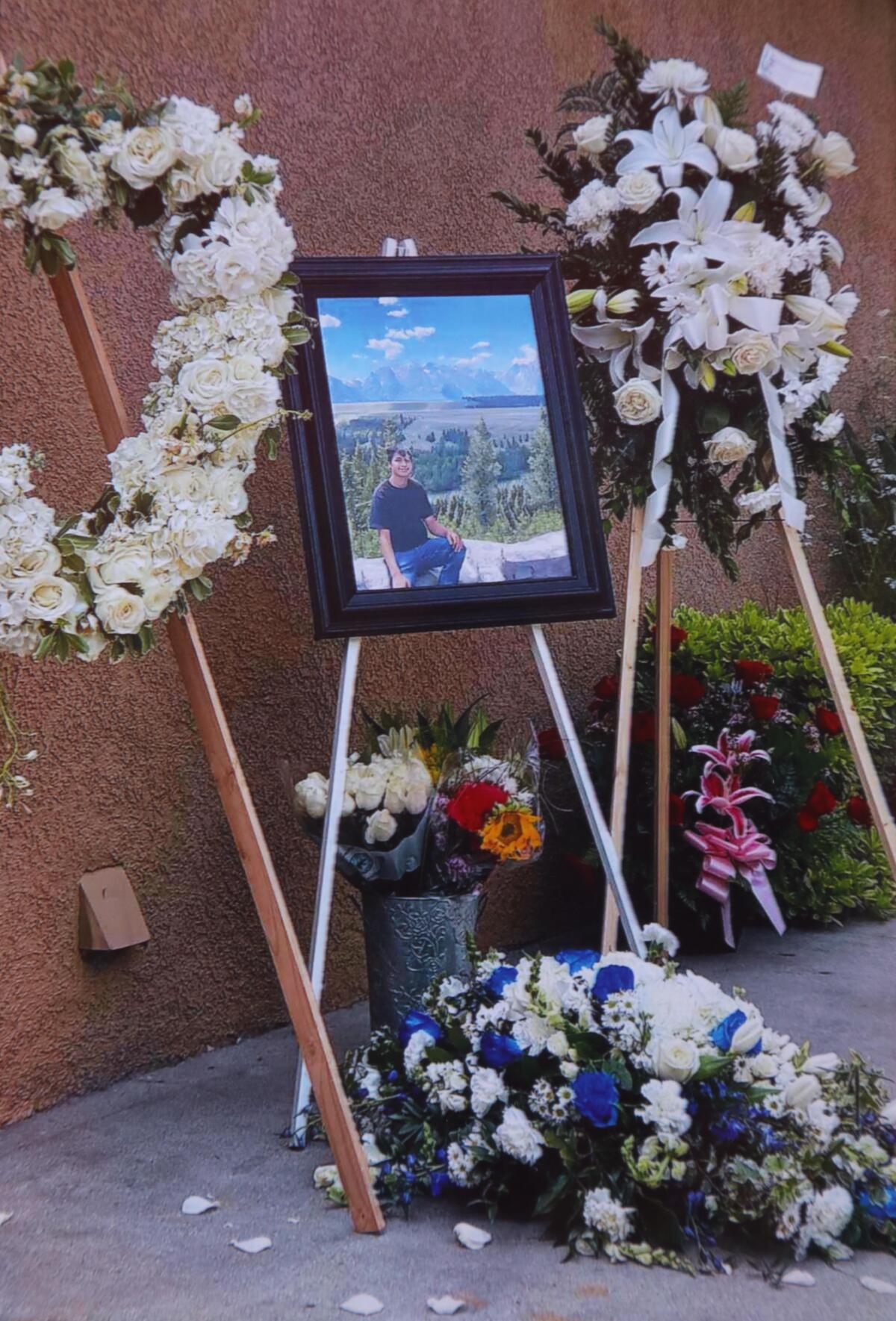After fatal overdose at L.A. juvenile hall, a mother grieves as drugs remain a threat

- Share via
Marlen Medina knew exactly what she would give her son when he returned from Sylmar’s Barry J. Nidorf Juvenile Hall: a blue Dodge Charger.
She was paying it off while her son, Bryan Diaz, served time for attempted murder. She expected him to be released sometime next year — a date he was eagerly awaiting.
“Pronto voy llegar a la casa, “ he wrote in one of the many letters he sent his mother from juvenile hall.
Soon, I’m coming home.
On May 9, Diaz died inside his cell from an overdose caused by fentanyl-laced narcotics — the first death inside the county’s juvenile halls in over a decade.
Five months after her son’s death, Medina, 46, drove up to a Hermosa Beach cafe in the same Blue Dodge she had planned to give him. It looked the way she imagined it would when Diaz took the wheel, except for one grim modification to the back windshield.
“F—-Sylmar Juvenile Hall,” reads the decal stretching across the entire back of the car. “R.I.P. Bryan Diaz (04-25-2005 ~ 05-09-2023).“
“It hurts me so much,” she said in Spanish, her voice cracking, “that I wasn’t able to take him to the DMV to get his driver’s license, that I wasn’t able to show him how to drive, that he didn’t drive the car that I bought him.”
In the months since Diaz’s death, the probation department has provided few answers about how the 18-year-old got access to drugs inside Nidorf Hall’s Secure Youth Treatment Facility, or SYTF, where youths accused or convicted of the most serious crimes are held. Medina said she has had no communication with the probation department about its investigation since the day her son died.
Since Diaz’s death, probation officials have taken steps to limit the flow of drugs in the facility, and even some of the department’s critics say those efforts have been successful. But the recent arrest of a 22-year-old SYTF detainee suspected of supplying fentanyl has led to allegations that staffers at the juvenile hall are involved in drug distribution.

On Oct. 2, L.A. County prosecutors charged Nicholas Ibarra with bringing narcotics into a jail and possession of drugs for sale, records show. Prosecutors said Ibarra, 22, possessed fentanyl inside Nidorf Hall on Aug. 8. He had previously been convicted of murder and burglary as a juvenile, according to the criminal complaint.
Ibarra has pleaded not guilty to the drug charges. His juvenile attorney declined to comment, and it’s unclear whether he has a lawyer representing him in adult court.
While he was being transferred to an adult jail, Ibarra claimed he could provide information about an officer dealing drugs inside Nidorf Hall, including the narcotics that led to Diaz’s death in the SYTF, according to Tom Yu, an attorney representing the arresting officers.
In just its first month of operation since reopening, L.A. County’s Los Padrinos Juvenile Hall has seen a brawl and a chaotic escape attempt.
In a letter to Interim Probation Chief Guillermo Viera Rosa, Yu said the officers “obtained an overwhelming amount of evidence that suggested” an officer and a teacher at Nidorf have been supplying fentanyl to youths. The names of the officer and the teacher were redacted in a copy of the letter that Yu provided to The Times.
Yu told The Times that officers Reggie Torres and David Corona were placed on administrative leave after reporting Ibarra’s statements to supervisors.
“This misconduct is being covered up,” Yu said in a written statement. “To date, this probation officer is still supplying fentanyl and the officer remains employed.”
Yu also alleged that Torres — who is the president of the union representing supervising probation officers — was being retaliated against for criticisms he’d levied against managers, according to the letter to the chief. Repeated calls to a spokesman for the union, SEIU Local 721, were not returned.

The probation department said it would not comment on pending criminal or personnel investigations, and responded to a detailed list of questions from The Times with a statement that said it would “vigorously seek criminal prosecution of anyone trying to introduce contraband into a juvenile facility.”
The agency said it has taken steps to “establish enhanced security protocols” and is monitoring its procedures to identity potential improvements.
Two probation department sources, who requested anonymity because they are not authorized to speak publicly about the ongoing investigation, said the officers may have been placed on leave for failing to promptly report Ibarra’s statements to supervisors — not because they sounded the alarm about alleged drug dealing by staffers, as Yu contended.
L.A. County has sued pharmacy benefit managers Express Scripts and OptumRx, alleging that they helped fuel the nation’s deadly opioid crisis.
Though both sources said Ibarra claimed he could identify the individual responsible for selling drugs, neither could substantiate Yu’s assertion about a link to Diaz’s overdose. One of the probation sources said Ibarra and Diaz were housed in the same unit at the time of the 18-year-old’s death.
Earlier this week, an ABC report claimed Ibarra was arrested in connection with Diaz’s death, but a spokeswoman for the district attorney’s office said Ibarra had not been charged with any crimes related to the overdose. No case has been presented to prosecutors related to Diaz’s death, said the spokeswoman, Tiffiny Blacknell.
**
In her first interview since her son’s death, Medina listed the milestones that he will never hit: graduation, marriage, fatherhood.
She holds the county’s probation department responsible.
“They were supposed to protect him,” she said. “I thought they were going to look after him.”
Teachers at Nidorf Hall, deputies and parents of incarcerated youths told The Times they were left that spring with the same sinking feeling: the facility meant to rehabilitate the county’s most troubled kids was going to be responsible for a death.

In a March court hearing, a judge expressed fear that a youth might die in custody soon after hearing from lawyers about two teens at Nidorf’s SYTF who were revived with the opioid overdose reversal drug Narcan after ingesting fentanyl-laced pills.
“It appears that it was a stroke of luck that the individuals that came across these two youths were trained in the use of Narcan and actually had it accessible,” Los Angeles County Superior Court Judge Miguel Espinoza said. “If the youth had been in a different unit, or it had been at a time when there was an untrained staff member, it appears highly likely that one or both of the youths would have passed away.”
Gerardo Cabanillas was promised probation if he confessed to a sexual assault he didn’t commit when he was 18 years old. After 28 years in prison, Cabanillas has been freed after DNA evidence proved his innocence, officials announced Monday.
Medina got the call about Diaz while she was in the bathroom on her 10 a.m. break from her job packing fruit. Her son had died in his cell, she said an official told her, but they would not share what happened.
Desperate for answers, she drove that evening to the juvenile hall. Word of the death had already spread, and when she arrived she felt that everyone at the entrance knew why she was there.
“Nobody would look me in the eye,” she recalled.
A detective later told her that her son had probably died of an overdose. Until that point, she’d assumed he’d been in a fight and didn’t believe he used hard drugs.

“I’m angry, I want them to give me names,” she said. “I want to know: What did they give the kids? Who was selling it?”
That was the last interaction she had with anyone from the probation department.
“I actually hadn’t thought about it until now,” she said. “They never called me again.”
Diaz was pronounced dead at 8:26 a.m. that day, and his death was ruled accidental due to the effects of fentanyl, according to an autopsy report made public last month. Responding officers deployed multiple doses of Narcan and performed CPR to no avail, records show.
Another youth housed in the unit told investigators he saw Diaz consume “an unknown blue tablet,” but it was unclear how long before his death that took place, according to the medical examiner’s report.

Investigators also recovered from Diaz’s room a rolled-up piece of paper secured with tape, according to the report, an indication he may have crushed and snorted the pill.
Concerns about fentanyl-laced pills being distributed within the juvenile hall have lingered most of the year. After Diaz’s death, probation officials stepped up efforts to reduce access to drugs inside the compound. Viera Rosa ordered that staff and visitors could bring only clear bags into the facility and announced increased searches of the halls for drugs.
**
Medina had three sons: Leonel, a bubbly 10-year-old; José Luis, a 25-year-old race car driver; and her middle child, Bryan.
He was always the son she was closest to. The one who always promised to buy them a house in Arizona. The one who tattooed her name on his neck. The one who wrote her poems.
Days before he died, he penned a poem about his mother and his girlfriend titled “Till we meet again.”
“I miss both these women sososo much that I would give up my life to spend a day with them right now.”
Javier Stauring, a former Catholic chaplain who led services inside juvenile halls, read the poem at Diaz’s funeral. He also organized a memorial for Diaz inside the SYTF’s chapel.
“When Bryan passed away, the first thing they did — there were 11 kids in the unit — was separate them all,” he said. “And so, you don’t give them an opportunity to even grieve together.”
The suit argues the county and state violate constitutional rights of older foster youths by subjecting them to ‘extreme housing instability and homelessness.’
At the memorial, Stauring, who now leads the criminal justice reform group Healing Dialogue and Action, asked the youths from Diaz’s unit what they remembered most about him.
“Almost everyone said, ‘The smile,’” he recalled.
After her son’s death, Medina made a photo album to remember him by. He grins as he makes honor roll in fourth grade, on the soccer field, during one of many family trips to Knott’s Berry Farm in Buena Park.
At the end of the album are two photos of Diaz at age 17, his smile slightly more reserved.
Medina said those were the last photos she took of her son at home before he was arrested.
Diaz was sent to SYTF “following attempted murder charges,” according to the autopsy report. Blacknell said the charges against him were “sustained” and the teen‘s release date had yet to be determined. Medina said she did not want to discuss her son’s case.
Diaz was at Central Juvenile Hall in downtown L.A. for nine months before being transferred to SYTF, his mother said. Six weeks later, he overdosed.
Medina said he’d never voiced any problems with the facility, not even a complaint about the food. She said he always sounded upbeat on their calls.
“He was just a positive kid — but he was a positive kid in a unit that was just flooded with contraband,” said Scott Budnick, a producer and criminal justice advocate who regularly went into Diaz’s unit as part of a mentoring program. “I saw the pills. You knew they were fake Xanax and fake Percocet — and you knew they were probably laced with fentanyl.”

Budnick described Diaz’s unit as being “just like the Wild, Wild West,” with drug use by incarcerated youths obvious to everyone who entered the facility — including staff.
“I’ll be honest, all of us coming in during those days, it was very difficult to do what we do because everyone was high,” he said.
Diaz’s death was a wake-up call to the county’s probation department. The agency said it has ramped up canine searches and limited outside meal orders to stop drugs from coming in masked as food deliveries.
Budnick said he’s noticed significantly less drugs within the facility in the last month, which he credits to improved staffing, more programming and better security.
“They have done a very, very good job of searching and finding fentanyl pills and then holding people accountable,” Budnick said. “That’s not to say we’re kind of completely out of the woods and it couldn’t revert back. But right now, it’s the best I’ve seen it since I started 20 years ago.”
When he took office, Los Angeles County Dist. Atty. George Gascón said up to 30,000 people could be eligible for re-sentencing under his progressive policies.
Prosecutors brought charges last month in adult court against two other youths for possession of drugs inside Nidorf Hall, according to the D.A.’s office. Those arrests took place in August, one day after court records allege Ibarra was caught with fentanyl.
Despite praise for the department’s increased efforts to search for drugs within the compound, it’s unclear what steps have been taken to curtail the role officer misconduct might play in drug abuse inside the facility. In September, the L.A. County Office of the Inspector General issued a report that noted continued allegations of staff bringing in cellphones and “illicit drugs.” The report did not say if any officers had been disciplined, fired or arrested for such behavior.
Medina said she had no idea her son’s death had become a catalyst for change — that his name was often chanted in public meetings, a symbol among activists of what’s at stake when the department flounders.
His death was the worst-case scenario. Rather than rehabilitate her son, Medina said she felt the probation department was responsible for his death, allowing him far too easy access to the drugs that killed him.
“If this would have happened to my child, in my house, under my responsibility, they would have came after me,” she said.
More to Read
Sign up for Essential California
The most important California stories and recommendations in your inbox every morning.
You may occasionally receive promotional content from the Los Angeles Times.




















